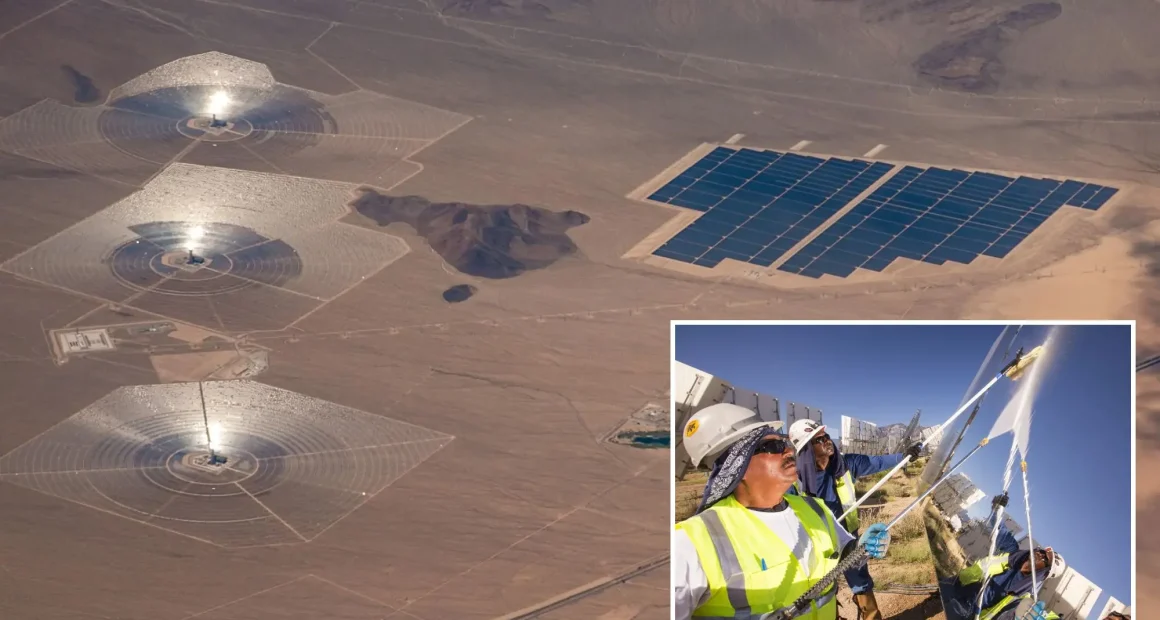From above, the Ivanpah Solar Power Facility in California’s Mojave Desert looks like something out of a futuristic vision.
On the financial side, though, the picture is far less inspiring.
The plant — with its three 459-foot towers and thousands of computer-guided mirrors known as heliostats — carried a $2.2 billion price tag. Construction began in 2010 and wrapped up in 2014, but the facility is now slated to shut down in 2026 after years of failing to generate solar power efficiently.
Back in 2011, the U.S. Department of Energy under President Barack Obama backed the project with $1.6 billion in federal loan guarantees. At the time, Energy Secretary Ernest Moniz praised Ivanpah as “an example of how America is becoming a world leader in solar energy.”
The three glowing towers of the Ivanpah facility may be striking, but the project has come to symbolize something else: costly government spending and risky bets on technology that quickly became outdated.
“Ivanpah stands as a testament to the waste and inefficiency of government-subsidized energy schemes,” Jason Isaac, CEO of the American Energy Institute, said in a statement to Fox News this past February. The plant, he argued, “never lived up to its promises, producing less electricity than projected while still depending on natural gas to remain operational.”
Workers hose down Ivanpah’s thousands of computer-controlled mirrors, known as heliostats.
When the facility launched in 2014, it was celebrated as the largest solar plant in the world — a promising step toward California’s renewable energy goals of using affordable, efficient technology to cut reliance on fossil fuels.
Situated near the California-Nevada border, about 65 miles southwest of Las Vegas, its illuminated towers shine as brightly as some of the casinos on the Strip.
Ivanpah’s towers rise 459 feet above the desert floor. Spanning five square miles, the facility was outfitted with roughly 173,500 heliostats — computer-guided mirrors designed to capture and direct sunlight. At full force, they can concentrate solar rays to temperatures reaching 1,000 degrees Fahrenheit on parts of the system.
“The idea was that you could use the sun to produce a heat source,” alternative energy consultant Edward Smeloff told The Post. “The mirrors reflect heat from the sun up to a receiver on top of the tower. That heats a fluid, which creates steam to spin a conventional turbine. It is complicated.”
The concept, though ingenious, came to resemble a Rube Goldberg machine — and from afar, even an art installation. For a time, Ivanpah was hailed as cutting-edge. But as the market shifted, the plant couldn’t keep up with cheaper, more efficient forms of solar power.
“It simply did not scale up,” Smeloff said. “It’s kind of an obsolete technology that’s been outpaced by solar photovoltaic technology.”
Unlike Ivanpah’s complex system, photovoltaic panels — the kind found on rooftops or stretched across solar farms — use semiconductors to directly convert sunlight into electricity through a far simpler process.
NRG Energy, the Texas-based company that invested $300 million and served as Ivanpah’s largest private partner, later acknowledged that assessment.
The tracking mirrors — or heliostats — posed an unexpected danger to wildlife, scorching birds that flew through the concentrated beams of heat.
“When the power purchase agreements were signed in 2009, the prices were competitive,” the company later acknowledged in a statement. “But advancements over time have led to more efficient, cost-effective, and flexible options for producing reliable clean energy.”
Ivanpah’s legacy, then, is not only one of high costs and inefficiency, but also of unintended harm to the environment it aimed to protect.
By 2026, Ivanpah’s glowing towers will go dark.
The facility has also carried a grim environmental cost. The Association of Avian Veterinarians estimates the plant has been responsible for at least 6,000 bird deaths annually. Birds flying through the concentrated beams of reflected sunlight are often incinerated midair. “If they fly in the area where the reflection is going up to the tower, they get fried,” Smeloff explained.
Some argue it didn’t have to end this way. A report released by the World Economic Forum earlier this year noted that private investors are often more agile than government programs in adopting and refining new energy technologies.
When Ivanpah came online in 2014, it held the title of the world’s largest solar plant.
But its struggles also fed into a broader debate over how best to fund renewable energy. “Unlike public market investors, private equity firms can implement transformative changes through hands-on management and aligned incentives,” a recent World Economic Forum report noted.
Critics have been more blunt. Steven Milloy, a senior fellow at the Energy & Environmental Legal Institute and former member of President Trump’s EPA transition team, argued: “No green project relying on taxpayer subsidies has ever made any economic or environmental sense. It’s important that President Trump stop the taxpayer bleeding by ending what he accurately calls the Green New Scam.”















